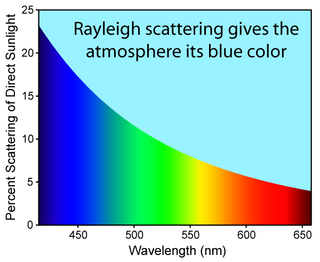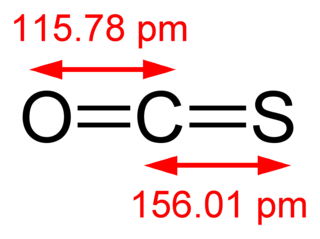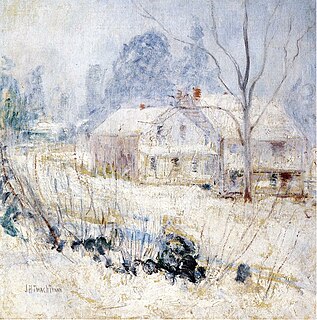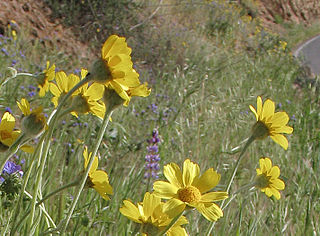
In mathematics, the polar coordinate system is a two-dimensional coordinate system in which each point on a plane is determined by a distance from a reference point and an angle from a reference direction. The reference point is called the pole, and the ray from the pole in the reference direction is the polar axis. The distance from the pole is called the radial coordinate, radial distance or simply radius, and the angle is called the angular coordinate, polar angle, or azimuth. The radial coordinate is often denoted by r or ρ, and the angular coordinate by φ, θ, or t. Angles in polar notation are generally expressed in either degrees or radians.

A steam turbine is a device that extracts thermal energy from pressurized steam and uses it to do mechanical work on a rotating output shaft. Its modern manifestation was invented by Charles Parsons in 1884.

Diffuse sky radiation is solar radiation reaching the Earth's surface after having been scattered from the direct solar beam by molecules or particulates in the atmosphere. Also called sky radiation, diffuse skylight, or just skylight, it is the determinative process for changing the colors of the sky. Approximately 23% of direct incident radiation of total sunlight is removed from the direct solar beam by scattering into the atmosphere; of this amount about two-thirds ultimately reaches the earth as photon diffused skylight radiation.
Cos, COS, CoS, coS or Cos. may refer to:

College of the Sequoias (COS) is a public two-year community college in Visalia, California. The college is named for the Giant Sequoia trees native to the nearby Sierra Nevada mountain range.

Solar irradiance is the power per unit area received from the Sun in the form of electromagnetic radiation as measured in the wavelength range of the measuring instrument. The solar irradiance is measured in watt per square metre (W/m2) in SI units. Solar irradiance is often integrated over a given time period in order to report the radiant energy emitted into the surrounding environment during that time period. This integrated solar irradiance is called solar irradiation, solar exposure, solar insolation, or insolation.

Carbonyl sulfide is the chemical compound with the linear formula OCS. Normally written as COS as a chemical formula that does not imply its structure, it is a colourless flammable gas with an unpleasant odor. It is a linear molecule consisting of a carbonyl group double bonded to a sulfur atom. Carbonyl sulfide can be considered to be intermediate between carbon dioxide and carbon disulfide, both of which are valence isoelectronic with it.

Cos Cob is a neighborhood and census-designated place in the town of Greenwich, Connecticut. It is located on the Connecticut shoreline in southern Fairfield County. It had a population of 6,770 at the 2010 census.
Church of Scientology of California v. Gerald Armstrong,, was a lengthy series of lawsuits and other legal actions, primarily in the California state courts, arising from Gerald Armstrong's departure from the Church of Scientology. The COS argued that Armstrong, a former COS employee, improperly took private papers belonging to the Church, while Armstrong argued that he took the papers to protect himself from improper disciplinary proceedings and that the Church did, in fact, discipline him improperly.

Lessingia is a genus of plants in the daisy family which are native to western North America. Several species are endemic to California.

Pleuropogon is a genus of Arctic and North American plants in the grass family known generally as semaphore grass.
Galium matthewsii is a species of flowering plant in the coffee family known by the common names bushy bedstraw and Matthews' bedstraw. It is native to the mountains and deserts of southeastern California, and southern Nevada.
Lorandersonia, commonly called rabbitbush, is a genus of North American flowering plants in the sunflower family.

Monolopia is a genus of flowering plants in the daisy family.

Nemacladus is a genus of flowering plants in the bellflower family known generally as threadplants. There are 18 accepted species native to the southwestern United States and northern Mexico. These are annual herbs with very slender, sometimes threadlike, branching stems bearing small five-lobed flowers.

WinCos is an automation solution produced by Bühler AG.
Galium munzii is a species of plant in the family Rubiaceae. It is native to California, Arizona, Nevada, and Utah.
Galium proliferum is a species of plants in the Rubiaceae. It is native to southern California, southern Nevada, southern Utah, Arizona, New Mexico, Texas, Coahuila and Nuevo León.
Galium wrightii, common name Wright's bedstraw, is a species of plants in the Rubiaceae. It is native to northwestern Mexico and southwestern United States: Sonora, Chihuahua, Arizona, New Mexico, western Texas, southwestern Utah, southern Nevada and southeastern California In California, this plant is ranked as rare, threatened, or endangered in CA; common elsewhere.











